Alnasl, Gamma2 Sagittarii (γ² Sgr), is an orange giant star located 96.9 light-years away in the constellation Sagittarius. With an apparent magnitude of 2.98, it is the seventh brightest star in the constellation. The giant marks the handle in the Archer’s bow. It is one of the bright stars that form the Teapot, an asterism that makes Sagittarius one of the most recognizable constellations in the night sky.
Star type
Alnasl is a giant star of the spectral type K1 III. It has a mass about twice that of the Sun and a radius 12 times the Sun’s. With a surface temperature of 4,760 K, it shines with 68 solar luminosities.
Alnasl is an evolved star. It has ceased hydrogen fusion in its core and is now burning helium. The giant is not massive to go out as a supernova when it comes to the end of its life cycle. Instead, it will expel its outer layers to form a planetary nebula and gradually fade away as a dense white dwarf.
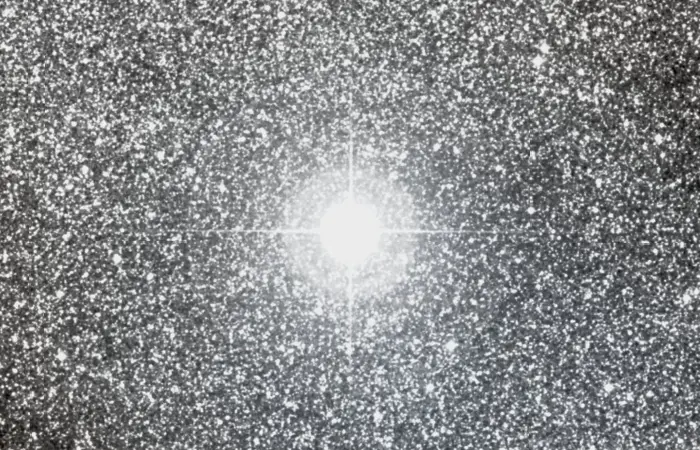
Alnasl (Gamma² Sagittarii), image: Wikisky
Gamma2 Sagittarii forms a visual pair with the fainter Gamma1 Sagittarii, which lies about 50 arcminutes to the north. With a visual magnitude that varies from 4.29 to 5.14, Gamma1 Sagittarii is faintly visible to the unaided eye in good conditions.
Even though they share the Bayer designation Gamma, the two stars do not form a binary star system and are not physically related. Gamma1 Sagittarii is a yellow supergiant of the spectral type F4 – G2Ib, located around 1,400 light-years away. It forms a triple star system with two A- and F-type main sequence stars. The supergiant is classified as a Cepheid variable and has the variable star designation W Sagittarii. It shines with 2,690 solar luminosities and only appears fainter than Alnasl because it is more than 14 times more distant.
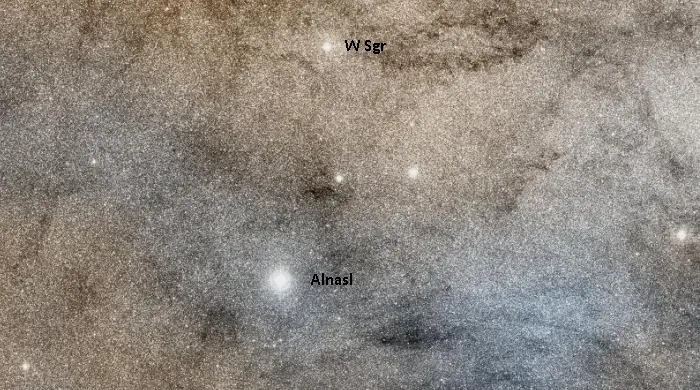
γ¹ Sgr and γ² Sgr, image: Wikisky
Facts
Alnasl is one of the eight bright stars that form the Teapot, an asterism that dominates the western part of Sagittarius. Other stars that form the pattern are Kaus Australis (Epsilon Sagittarii), Nunki (Sigma Sagittarii), Ascella (Zeta Sagittarii), Kaus Media (Delta Sagittarii), Kaus Borealis (Lambda Sagittarii), Phi Sagittarii, and Tau Sagittarii. Alnasl marks the spout of the Teapot. On a clear, dark night, the Milky Way appears as steam coming from the spout.
Alnasl is one of the nearest bright stars to the Galactic centre. Sagittarius A*, the Milky Way’s central black hole, appears on the imaginary line drawn from Ascella through Kaus Media and extended by a little less than the distance between the two stars. Alternatively, the Milky Way centre can be found just south of the midpoint of the imaginary line connecting Antares, the brightest star in Scorpius, and Tau Sagittarii, the easternmost star of the Teapot. Sgr A* lies 26,673 light-years from the solar system.
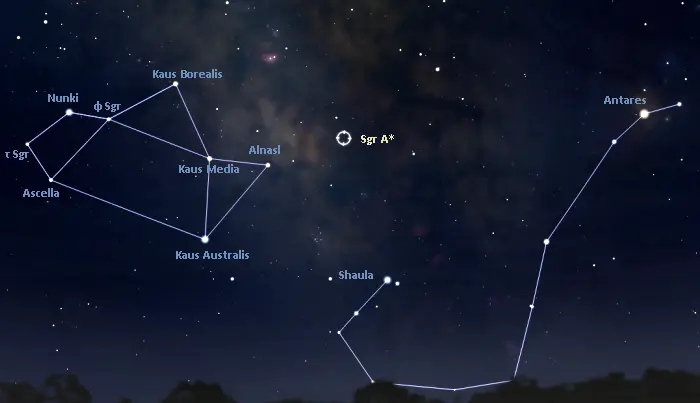
Alnasl, the Teapot, and the Galactic centre, image: Stellarium
Name
The name Alnasl (pronunciation: /ælˈnæzəl/) comes from the Arabic al-naşl, meaning “arrowhead.” It was historically also spelled Nasl, Al Nasl, and El Nasl. The name was approved by the International Astronomical Union’s (IAU) Working Group on Star Names (WGSN) on August 21, 2016.
In Arabic astronomy, Alnasl was also known as Nushaba. The name Nushaba has the same meaning as Alnasl, “the head of the arrow.” It was derived from the phrase Zujj al-Nashshaba.
Gamma Sagittarii was listed as Awal al Waridah in the 17th century Egyptian astronomer Al Achsasi al Mouakket’s Calendarium. The name means “the first [star] of the [ostrich] going down to the water.” It comes from the Arabic phrase al Naʽāma al Wārida, which was the name of an asterism formed by Alnasl with Kaus Media (Delta Sgr), Kaus Australis (Epsilon Sgr), and Eta Sagittarii. In Arabic astronomy, the stars represented an ostrich going down to the river to drink. The river was represented by the Milky Way. The stars Phi Sagittarii, Tau Sagittarii, Ascella (Zeta Sagittarii), Chi Sagittarii, and Nunki (Sigma Sagittarii) were seen as the Returning Ostriches (Al Naʽām al Ṣādirah).
In Chinese astronomy, Alnasl was known as 箕宿一 (Jī Sù yī), the First Star of Winnowing Basket. Winnowing Basket was an asterism formed by Alnasl with Kaus Media (Delta Sgr), Kaus Australis (Epsilon Sgr), and Eta Sagittarii.
In ancient Mesopotamia, Alnasl, Kaus Media and Kaus Australis formed an asterism known as the Swallow (Sin-nun‑tu or Si-nu-nu‑tum in Akkadian).
Location
Alnasl is easy to find because it is relatively bright and part of a conspicuous asterism, the Teapot. It marks the spout of the Teapot and the head of the Archer’s arrow. It appears just west of the three stars that outline the Archer’s bow, Kaus Borealis, Kaus Media, and Kaus Australis. The bright Antares and the Fish Hook of Scorpius can be used for orientation.
The bright Lagoon Nebula and Trifid Nebula (M8 and M20) and the open cluster Messier 21 (Webb’s Cross) appear almost directly north of the star.
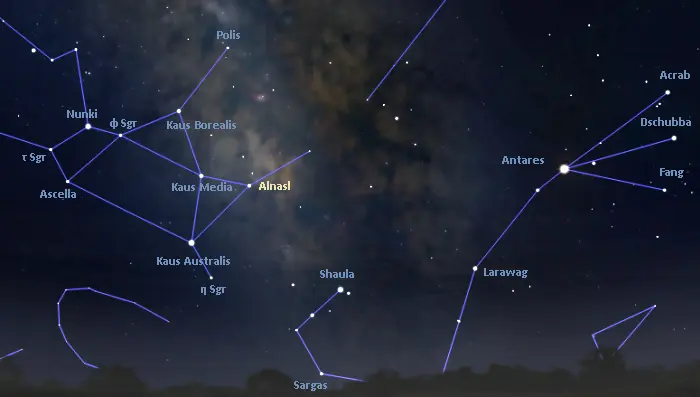
The location of Alnasl, image: Stellarium
Constellation
Alnasl is located in the constellation of Sagittarius. Representing the celestial Archer, Sagittarius is one of the Greek constellations, catalogued by the Greco-Roman astronomer Claudius Ptolemy of Alexandria in his Almagest in the 2nd century CE. In Greek mythology, the constellation is associated with a centaur whose identity is uncertain. Some take it to represent the centaur Chiron, while others link it with the satyr Crotus (Krotos), the inventor of archery in Greek lore.
Sagittarius is the 15th largest of the 88 constellations. It stretches across 876 square degrees of the southern sky. With seven stars brighter than magnitude 3.0, the constellation is easy to identify. Its brightest stars form the Teapot, a prominent asterism that appears next to the rich band of the Milky Way galaxy.
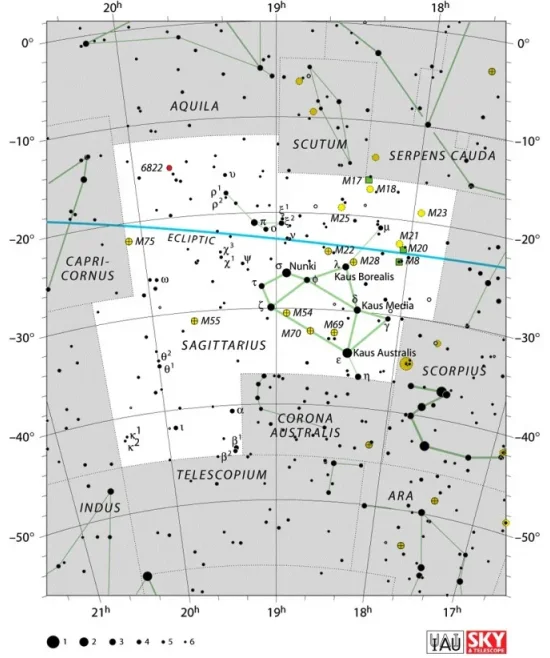
Sagittarius constellation map by IAU and Sky&Telescope magazine
Kaus Australis, the brightest star in Sagittarius, shines at magnitude 1.85 from a distance of 143 light-years. The hot blue giant is one of the three stars that outline the Archer’s bow. The other two, Kaus Borealis and Kaus Media, are evolved K-type stars, like Alnasl.
Other notable stars in Sagittarius include the hot blue B-type star Nunki (Sigma Sagittarii), the triple star system Zeta Sagittarii (Ascella), the Wolf-Rayet star WR 104, the red supergiants VX Sagittarii and KW Sagittarii, the blue supergiant Polis (Mu Sagittarii), and the luminous blue variable V4647 Sagittarii, popularly known as the Pistol Star.
Sagittarius hosts many bright deep sky objects, including more Messier objects than any other constellation. These include the open clusters Messier 23 and Messier 25, the globular clusters Messier 22, Messier 28, Messier 54, and Messier 55, the Small Sagittarius Star Cloud (Messier 24), and the nebulae Messier 8, Messier 17, and Messier 20, better known as the Lagoon Nebula, the Omega Nebula, and the Trifid Nebula. The constellation is also home to Sagittarius A*, the supermassive black hole at the centre of the Milky Way.
The best time of the year to observe the stars and deep sky objects in Sagittarius is during the month of August, when the constellation is higher above the horizon in the evening. The entire constellation is visible from locations south of the latitude 55° N.
The 10 brightest stars in Sagittarius are Kaus Australis (Epsilon Sgr, mag. 1.85), Nunki (Sigma Sgr, mag. 2.05), Ascella (Zeta Sgr, mag. 2.59), Kaus Media (Delta Sgr, mag. 2.70), Kaus Borealis (Lambda Sgr, mag. 2.82), Albaldah (Pi Sgr, mag. 2.89), Alnasl (Gamma² Sgr, mag. 2.98), Eta Sagittarii (mag. 3.11), Phi Sagittarii (mag. 3.17), and Tau Sagittarii (mag. 3.326).
Alnasl – Gamma2 Sagittarii
| Spectral class | K1 III |
| U-B colour index | +0.77 |
| B-V colour index | +1.01 |
| Apparent magnitude | 2.98 |
| Absolute magnitude | +0.62 |
| Distance | 96.9 ± 0.5 light-years (29.7 ± 0.2 parsecs) |
| Parallax | 33.67 ± 0.18 mas |
| Radial velocity | 22.0 ± 2.9 km/h |
| Proper motion | RA: -53.92 ± 0.23 mas/yr |
| Dec.: -180.90 ± 0.13 mas/yr | |
| Luminosity | 68 L☉ |
| Radius | 12 R☉ |
| Temperature | 4,760 K |
| Metallicity | -0.36 dex |
| Surface gravity | 2.72 cgs |
| Constellation | Sagittarius |
| Right ascension | 18h 05m 48.4880988s |
| Declination | –30° 25′ 723458″ |
| Names and designations | Alnasl, Nushaba, Awal al Warida, Gamma2 Sagittarii, γ Sgr, 10 Sagittarii, HD 165135, HR 6746, HIP 88635, SAO 209696, FK5 679, GC 24632, GCRV 10526, CD-30 15215, CPD-30 5241, CPC 17 9681, PPM 297231, LTT 7181, NLTT 45887, JP11 2922, GSC 07391-02710, IRAS 18025-3025, 2MASS J18054848-3025265, NSV 10173, PLX 4131.00, UBV 15364, TYC 7391-2710-1, Gaia DR2 4049975081502371328, Gaia DR3 404997508157172992 |